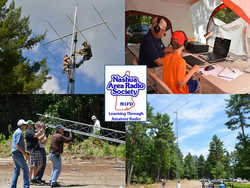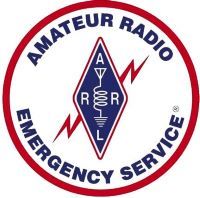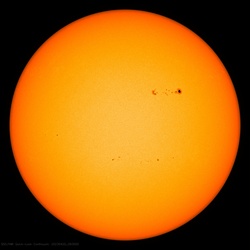 April 20, 2023 John E. Ross, KD8IDJ, Editor
| ||||||
Annual Armed Forces Day Crossband Test The US Department of Defense (DoD) will host this year's Armed Forces Day (AFD) Crossband Test on May 13, 2023. This annual event is open to all licensed amateur radio operators and will not impact any public or private communications. For more than 50 years, military and amateur stations have taken part in this event.
Military stations will transmit on selected frequencies and will announce the specific ARS frequencies monitored. All of the times are Zulu (Z), and all frequencies are Upper Side Band (USB) unless otherwise noted. The frequencies used for the test will not stray outside the confines of the exercise. A complete list of frequencies, time periods, QSL cards, and other information can be found at DoD MARS - Armed Forces Day. AFD is a time of honor. It will be celebrated on Saturday, May 20, 2023. The first AFD was celebrated with parades, open houses, receptions, and air shows. Today, many events and activities take place and may include multi-service military displays in areas open to the public, various educational activities that teach children about the armed forces, and large parades with local celebrations. The longest running AFD parade in the United States is held in Chattanooga, Tennessee. Certain types of music will be played at AFD 2023 events to show respect to those in the armed forces who died for their country. 2023 Online Ham Bootcamp The Nashua Area Radio Society's spring 2023 online Ham Bootcamp will be held on Saturday, May 13, from 10 AM to 6 PM Eastern Time. Ham Bootcamp includes a series of demonstrations and tutorials designed to help newly licensed Technician-, General-, and Extra-class license holders get on the air. Ham Bootcamp is also a great opportunity for hams who are interested in seeing what the hobby has to offer. The online Ham Bootcamp program is available to all licensed and prospective amateur radio operators. You can register for the next Ham Bootcamp session here. For additional information, contact Anita Kemmerer, AB1QB, of the Nashua Area Radio Society at [email protected]. The Nashua Area Radio Society is an ARRL Affiliated Club. Dr. Ulrich Rohde Receives IEEE Award Dr. Ulrich Rohde, N1UL, received the 2023 Institute of Electrical and Electronics Engineers (IEEE) Communications Society Distinguished The award recognizes an industry executive whose leadership has resulted in major and outstanding advances and new directions in the information and communications business. According to the IEEE, Dr. Rohde won the award "for contributions and leadership in radios and electronic test-measurement equipment that has supported the design of modern communication systems and their industrial implementations." Dr. Rohde has been an avid amateur radio operator with licenses in the United States and Germany. He has been licensed since 1956 and involved mostly in technology and systems. In 2015, he won first place in the ARRL International DX Contest in the Northern New Jersey Section. He also operates as N1UL/MM on his yacht, the Dragonfly, and is the trustee of the Marco Island Radio Club, K5MI. ARRL The National Association for Amateur Radio® recognized Dr. Rohde as the recipient of the IEEE Photonics Society Engineering Achievement Award in 2022. In November 2022, he was inducted to the Indian National Academy of Engineering. Dr. Rohde is an ARRL Maxim Society and Life Member. Ohio NVIS Day 2023 is Set for April 22 Ohio Near Vertical Incidence Skywave (NVIS) Day 2023 will be held Saturday April 22, from 10 AM to 4 PM EDT. This is a non-contest event and all amateur radio operators are invited to participate.
Take a step forward and answer the question, "How would we actually use these antennas?" For 2023, two operating scenarios have been added to make your day more fun and provide a learning experience for actual disaster communications. There will be a commercial power blackout, and participants will need to communicate within their ARES district and to "The Sarge" at the Ohio Emergency Operations Center in Columbus. Stations will construct and test NVIS antennas with transmit power limited to 100 W. Power for the NVIS station will be any form of off-grid supply, like a generator, battery, or solar. Stations may test antenna coverage by contacting as many different locations as possible. This year, they are collecting grid squares and s-meter readings as part of the exchange. Stations should originate a message to their ARES district, local net, OHDEN, OSSBN, and W8SGT, to report their location and county and alone with whether they are participating or not participating. WinLink may also be used, as long as it is sent via RF, local node (VHF, UHF), or an HF node to KD8SCL or W8SGT. For more information on node locations, visit Winlink.org. Operating frequencies are proposed to be on the 80- and 40-meter bands. Voice is the preferred testing format. Submit your results to [email protected] and be sure to include a photo of your group or your antenna! For more information on Ohio NVIS day, visit Ohio ARES (arrl-ohio.org). EME: Pandemic and Patience Doug Hansel, AA1UI, found himself with some extra time during the pandemic and thought that it might be the right time to learn how to make Earth-moon-Earth (EME) contacts. "First, I did a lot of reading and talking to other amateurs. Then, I realized I needed better equipment, software, and a lot of patience," said Hansel. Hansel was gifted a 15-element Yagi but had to sell some older equipment to upgrade to a better amplifier and equipment. After many attempts, his first contact was in 2021. He kept at it and was thankful for all of the help he received. Hansel stressed the need for patience, stating, "What's fun is that I really didn't know what I was doing, but the EME community was very generous with their time and advice in helping me tick this off my bucket list." He made a detailed video of his experience that can viewed here: https://www.dropbox.com/s/2n4rlnoh37rmgt7/EME%20Project%20short%20FB720-FINAL.mp4?dl=0. Hansel was first licensed in 1977 and now holds an Amateur Extra-class license. He is an ARRL member. Amateur Radio in the News ARRL Public Information Officers, Coordinators, and many other member-volunteers help keep amateur radio and ARRL in the news. "40-year-old radio society wants to get more involvement in public activities" / The Enquirer Journal (North Carolina), April 14, 2023 -- The Union County Amateur Radio Society is an ARRL Affiliated Club. "Meteorologist featured speaker at amateur radio association meeting" / Daily Sentinel (New York), April 15, 2023 -- The Fort Herkimer Amateur Radio Association is an ARRL Affiliated Club.
ARRL Podcasts On the Air The March/April 2023 issue of On the Air featured an article on "The Incident Command System and Amateur Radio," that introduced the Incident Command System (ICS), an emergency management system that public safety agencies use to respond to everything from small incidents to large-scale emergencies. ARRL Director of Emergency Management Josh Johnston, KE5MHV, joins this episode of the podcast to share more about the system's origins and uses, where and how amateur radio operators fit into the system, and where to get ICS training. ARRL Audio News The On the Air podcast is available on iTunes (iOS) and Stitcher (Android). The On the Air podcast and ARRL Audio News are also on blubrry -- On the Air | ARRL Audio News. Announcements The National Council of Volunteer Examiner Coordinators (NCVEC) has released a 2nd Errata for the 2023 - 2027 General Class Element 3 Question Pool. The NCVEC Question Pool Committee (QPC) has released the second revision of the 2023 - 2027 General Class element 3 Question Pool. This revision supplants the question pools released on December 1, 2022, and February 1, 2023. The changes are reflected in the new General pool downloadable files, dated April 15, 2023. Three questions have been withdrawn from use and removed from the pool: G6B09, G9C06, and G9D13. Most of the other questions had minor changes. ARRL VEC teams are advised to check the NCVEC website or the ARRL website regularly for updates to the question pools, which may include errata and withdrawn questions. The new General Class Element 3 Question Pool goes into effect on July 1, 2023. In Brief... ARRL Life member Richard L. King, K5NA, passed away on Wednesday April 12, 2023. King held an Amateur Extra-class license and was a well-known and respected member of the amateur radio community. King's contributions to radiosport will be greatly missed. First licensed in 1958, King was a skilled operator, a longtime DXer, and contester, and had been selected as a referee for the World Radiosport Team Championship (WRTC) 2022, which will be held in Italy in July 2023. A tribute is posted on the WRTC 2022 website. King had 340/374 (current/total) entities confirmed in the ARRL DXCC Mixed Standings. He had 3,167 confirmed entities in the ARRL DXCC Challenge, of which 321 were on 160 meters. A memorial service will be held later in the year, according to his widow. The K7RA Solar Update Tad Cook, K7RA, of Seattle, Washington, reports for this week's ARRL Propagation Bulletin. For this week's ARRL Propagation Bulletin ARLP016: This week's sunspot numbers and solar flux were higher than the week before.
Average daily sunspot numbers were more than doubled, from 70.6 to 146.9, and average daily solar flux increased from 141 to 164.5. Both figures represent a substantial increase in solar activity. Planetary A index averages went from 7.6 to 8.1, while middle latitude A index advanced from 6.4 to 7.3. Predicted solar flux over the next few weeks is 145, 140, and 135 on April 20 - 22; 130 on April 23 - 24; 125 on April 25 - 26; 160 on April 27 - 29; 165 on April 30; 172 on May 1 - 3; 170 on May 4; 172 on May 5 - 7; 178 on May 8; 182 on May 9 - 12, then 175, 178, and 170 on May 13 - 15; 168 on May 16 - 17; 175 on May 18, and 172 on May 19 - 21. Predicted planetary A index is 20, 16, 12, and 10 on April 20 - 23, then 8, 5, 15, and 18 on April 24 - 27; 15 on April 28 - 30, then 12 and 10 on May 1 - 2; 8 on May 3 - 4; 5 on May 5 - 6; 12 on May 7; 5 on May 8 - 10, then 8 on May 11 - 12; 5 on May 13 - 18, then 10, 8, 5, and 5 on May 19 - 22. Dan Handa, W7WA, commented on the news item last week about the current solar cycle reaching a peak earlier than predicted, perhaps by the end of this year. I told him I hope it will not peak early because I want to see several more years of increasing activity. Dan sent a detailed graph of Solar Cycle 19, from 1954 to 1966, and wrote, "I have read more than once [that] a slow rise means a low sunspot max. The previous [Solar] Cycle 24 took 5 years to reach a relatively low maximum. A rapid increase can mean a high sunspot maximum. The granddaddy of our lifetime, [Solar] Cycle 19, peaked in three years!" I was unaware of this. Sunspot numbers for April 13 - 19, 2023, were 154, 153, 151, 155, 162, 140, and 113, with a mean of 146.9. 10.7-centimeter flux was 159.5, 171.3, 175.8, 177.8, 166.6, 153.2, and 147, with a mean of 164.5. Estimated planetary A indices were 6, 7, 9, 4, 6, 13, and 12, with a mean of 8.1. Middle latitude A index was 5, 10, 8, 4, 6, 9, and 9, with a mean of 7.3. Send your tips, reports, observations, questions, and comments to [email protected]. When reporting observations, don't forget to tell us which mode you were operating. A comprehensive K7RA Solar Update is posted Fridays on the ARRL website. For more information concerning radio propagation, visit the ARRL Technical Information Service, read "What the Numbers Mean...," and check out the Propagation Page of Carl Luetzelschwab, K9LA. A propagation bulletin archive is available. For customizable propagation charts, visit the VOACAP Online for Ham Radio website. Share your reports and observations. A weekly, full report is posted on ARRL News. Just Ahead in Radiosport Yearlong -- ARRL Volunteers On the Air (VOTA). See the State Activations Schedule for weekly W1AW Portable Operations, including:
Upcoming Contests:
Visit the ARRL Contest Calendar for more events and information.
Upcoming Section, State, and Division Conventions
Search the ARRL Hamfest and Convention Database to find events in your area. Have News for ARRL? Submissions for the ARRL Letter and ARRL News can be sent to [email protected]. -- John E. Ross, KD8IDJ, ARRL News Editor
ARRL -- Your One-Stop Resource for
Subscribe to...
Free of charge to ARRL members...
| ||||||
 The AFD Crossband Test is a unique opportunity to test two-way communications between military communicators and radio stations in the Amateur Radio Service (ARS), as authorized in 47 CFR 97.111. These tests provide opportunities and challenges for radio operators to demonstrate individual technical skills in a tightly controlled exercise scenario.
The AFD Crossband Test is a unique opportunity to test two-way communications between military communicators and radio stations in the Amateur Radio Service (ARS), as authorized in 47 CFR 97.111. These tests provide opportunities and challenges for radio operators to demonstrate individual technical skills in a tightly controlled exercise scenario. Access to the session will be provided via
Access to the session will be provided via -resized.jpg) Industry Leader Award.
Industry Leader Award. The purpose of NVIS day is to construct and try various working NVIS antenna ideas. These antennas are low to the ground and provide coverage generally within a 400-mile radius, which is extremely important for regional HF communications in an emergency.
The purpose of NVIS day is to construct and try various working NVIS antenna ideas. These antennas are low to the ground and provide coverage generally within a 400-mile radius, which is extremely important for regional HF communications in an emergency..jpg)

-2023-small.jpg) April 19 - April 25 North Dakota W1AW/0
April 19 - April 25 North Dakota W1AW/0-Blue.jpg)








